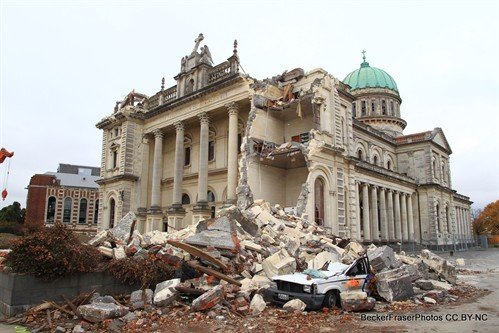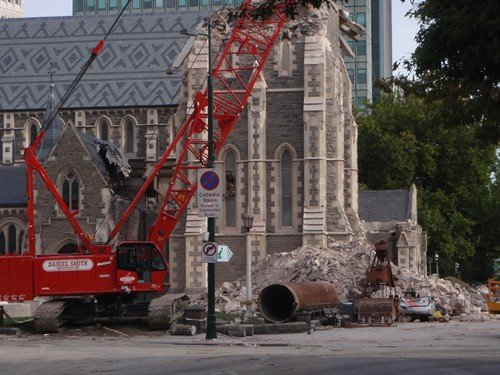Stories from the Church in the Quakes
Within minutes of the 22 February 2011 earthquake, images of the damaged Anglican and Catholic cathedrals in Christchurch were broadcast around the world. News programmes showed footage of a woman rescued from the tower of the Christ Church Cathedral and cars crushed under rubble from the Cathedral of the Blessed Sacrament.
BeckerFraserPhotos Creative Commons BY-NC
In many ways this became the public story of churches in Christchurch: the damage to their buildings and disruption of their services. Congregations began to share undamaged sites, or to continue their services in community centres and school halls. The Christ Church Cathedral was deconsecrated in preparation for a partial demolition and the large dome was removed from the Cathedral of the Blessed Sacrament.
Wellington Emergency Management Office Creative Commons BY-NC-SA 3.0 NZ
But just as a church is more than its building, so too is the story of the Church in the quakes. Over the last year, CEISMIC has been working with author Melissa Parsons to archive interviews she conducted with leaders and congregation members of 17 different Christian denominations in the hopes of expanding the story. Today, the first 10 of these interviews are available in the QuakeStudies digital archive in the aptly-named Church in the Quakes Te Hāhi i Ngā Rūwhenua collection.

Melissa began the Church in the Quakes project in August 2012 by sending out surveys to 220 churches in the Canterbury region. From this, 95 replies were received, with at least one from nearly every denomination present in the greater Christchurch area. In addition to these surveys, Melissa conducted 50 face-to-face and skype interviews with 56 individuals and couples. Transcripts from these interviews are currently being prepared and will be added to the above collection as the work is completed, along with the audio (and video files where present). The stories are also available in her book Rubble to Resurrection: Churches Respond in the Canterbury Quakes.
Since Melissa’s own story is not available in the collection, we asked her to tell us about her experiences in the earthquakes, her motivation for the projects, and her thoughts for the future of the Church in Canterbury:
In The Church in the Quakes project, you documented the experiences of many people involved in the church. I would love to hear your own experiences with the earthquakes.
As Christchurch locals, my family and I have lived through all of the quakes as participant-observers. For the September event, we were living in Addington, and our two boys were four and two. Our home at the time was a modern two-storey townhouse which withstood the shaking well, but the whole experience was still a rude awakening for everyone. It was a particularly scary one for our son on the top bunk in an upstairs bedroom. He has not wanted to sleep on a top bunk again ever since. In contrast, the two year old merely opened a bleary eye in his cot, said ‘Big wobble!’ and went back to sleep.
In February, the family was separated in three different locations; me driving in to University, my husband Daryl at work in Cashel St and both boys were at daycare in Spreydon. We were all reunited at home by 5pm that night after our respective treks home. It was a relief to know that Daryl had opted not to go up to Cashel Mall for lunch that day. He spent the afternoon helping a random stranger get home to her place in Westmorland. I was one of the last parents to arrive at daycare to collect the boys, after a two and a half hour trip (normally 15 minutes). The boys were calm and well-cared for, full of stories about how the fishies fell out of the tank in one of the aftershocks! That night was a horrendous string of tremors every 20 minutes, with very little sleep and the certain knowledge that people in our city were trapped and suffering. The next day, my husband was called in to work by his employer, and began assisting Workplace Support in their task of helping businesses to care for their staff in the face of such unprecedented upheaval and stress. I wanted to be out there too, shovelling liquefaction, but accepted that my job at that point was to provide normality as much as possible for the kids.
The city and its people have lost much, some more than most. I can claim a connection ‘once removed’ to three of those who lost their lives (a brother-in-law’s optometrist, dad’s second cousin’s nephew, a workmate’s neighbour). Our home was not severely damaged in either quake but one of my cousins is still battling her insurer five years on to obtain a payout for their re-repairs. In all, it has been an intense and surreal period of history to live through.
What are your own connections to the Church?
I usually describe myself as having Anglican roots, but Baptist branches! I was educated at St Michael’s School up to Year 6 and attended St Barnabas’ Anglican Church Youth Group as a teenager. As a young adult, I made a conscious decision to be baptised and to own faith for myself. At this point, I began attending the then Spreydon Baptist Church (now South West Baptist) and still regard this place as a ‘spiritual home.’ In keeping with many Christians of my generation, for whom denominational loyalty is less of a priority than in the past, I have become comfortable worshipping in various settings. Upon our marriage, my husband and I decided to become part of the Grace Vineyard Church, where we stayed for five years. Then followed a period of involvement with ‘planting’ a new church congregation in Halswell with Harmony Church. At the time of writing, our family is putting down roots at Hope Presbyterian Church in Hornby where we hope to stay and be of service. I retain amicable links with all of the churches mentioned here and am grateful to each one for their input into my spiritual life and for the unique flavour which they bring to the wider Church in the city.
How did you come to envision the Church in the Quakes project and to work on it?
I originally envisioned collecting together the ‘untold stories’ of the positive community contribution made by the various churches in greater Christchurch in the aftermath of the quakes. My hope was that such a collection would go some way towards balancing the record, which seemed to me to be skewed in the mainstream media. Typically, churches were being presented as broken buildings, and sources of insurance wrangling but little else. To someone familiar with several of the church networks in the city, this was a manifestly inadequate representation of the reality. I began my research in 2012 with a postal survey, which included a request for people willing to be interviewed. By the end of two years, this had grown to become a corpus of 95 survey replies, and 50 interviews with 56 individuals representing 17 different denominations. I was not commissioned by any one church to do this, nor was I particularly well known to church leaders in the city at the time. However, I felt that the task could be mine by virtue of my passion for it, my level of skill in writing and my prior experience in a related project (I was fortunate to work with the UC/NCW ‘Women’s Voices’ Project as a volunteer interviewer prior to undertaking this task). I had support and backing from the Anglican Church via Rev John Day (then Archdeacon for Mission); from the Catholic Church via Matt O’Connell and the Diocesan Earthquake Recovery Fund, and from the evangelical networks in the city thanks to Max Palmer (Life Resources) and Murray Robertson (Former President, NZ Baptist Union).
The project has also been published as a book, Rubble to Resurrection: Churches Respond in the Canterbury Quakes. Can you tell us about the book and how it differs from The Church in the Quakes project?
Whereas The Church in the Quakes Project is a collection of the interviews given during the research process, Rubble to Resurrection is based on both the personal interviews and the survey information, and tells the story of the churches’ response in greater depth. The book is divided into three sections, The Church Responds, the Church Grieves and the Church Rebuilds. Within these sections, each of the 24 chapters begins with a personal story introducing the topic in focus. Feedback from readers has been overwhelmingly positive and suggests that people have appreciated finding out about some of the ‘good stuff’ that was happening as the disaster unfolded. The book gathers together stories from survivors and families of loved ones, from church leaders and from the ordinary folk in the pews, from New Zealanders and overseas visitors alike. It offers a unique perspective and allows a wide space for respondents to acknowledge the role of their faith in motivating and sustaining their community response.
How do you think that churches are faring now, five years after the quake?
It is hard to answer this question in a generalised sense, as different denominations and individual congregations are at different places in their recovery journey. There are congregations still meeting in temporary premises, but hoping to have their building rebuilt. There are at least four newly rebuilt church buildings. A few congregations have merged with a neighbouring parish and still others have completed cosmetic repairs and are back to 'business as usual.' Overall though, it would be true to say that for around 85% of churches, the congregation has stabilised or grown since the quakes, and that any decreases in attendance and/or giving (those more quantifiable factors!) had reversed for the most part by the end of 2012. As far as the ‘intangibles’ go, there are also many positive things to note. Churches have gained confidence in their ability to mobilise in a crisis and make a difference in their communities. Individuals have been stretched by the experience of putting their faith into action when it counted most. Congregations have grown spiritually, either through suffering loss alongside their neighbours, or by giving sacrificially to assist those worst affected. Members are also hopeful that the Church has gained a little more credibility in the eyes of those who are aware of its efforts and willing to acknowledge them. Churches now are more linked to each other (www.raranga.org.nz) and more likely to be invited into community-based conversations within their neighbourhoods. Individuals from within the churches continue to exhibit the wide range of responses you would expect from any human community – enthusiasm and tiredness, willingness and weariness; hopefulness and frustration – but all are keen to have their experience count for something in terms of assisting others in similar situations in future.
Do you have any other comments or thoughts you would like to impart?
I am delighted to offer this collection to the CEISMIC database and hope it will be of lasting interest and benefit to researchers, historians and members of the general public. It provides a unique perspective from clergy and lay people alike, who combined a very real desire for the ‘care of souls’ with an intensely practical response to physical needs. The collection is not an exhaustive summary of everything done by every church, but I believe it does offer a credible representative sampling, and a good starting point for anyone wanting to go further and look deeper. I would like to express once again my sincere gratitude to each and every person who trusted me with their stories and gave permission for them to be archived here. May the Lord bless you and all those who are touched by the hearing of them.
CEISMIC would like to thank Melissa for her hard work and dedication to seeing this project through. Like so many other parts of Christchurch, this archive could not exist without the help of talented and determined individuals like Melissa. Kia kaha and we look forward to continue our work with you in the future.


